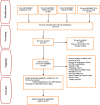Telemedicine Services in Chronic Obstructive Pulmonary Disease: A Systematic Review of Patients' Adherence
- PMID: 35382079
- PMCID: PMC8978036
Telemedicine Services in Chronic Obstructive Pulmonary Disease: A Systematic Review of Patients' Adherence
Abstract
Background: The current systematic review aimed to determine the effect of telemedicine services on adherence in patients with chronic obstructive pulmonary disease (COPD) and to describe the type of adherence and applied devices and modules.
Materials and methods: We reviewed PubMed, Scopus, Web of Science, and Embase databases to identify relevant studies from the time of inception of these databases to March 10, 2019, using three groups of keywords. The first group comprised words describing COPD, the second group included words describing types of telemedicine interventions, and the third group contained words describing adherence. The reference list of identified articles was also hand-searched to retrieve possibly relevant articles.
Results: In total 21 articles were included, in which 13 reported a positive effect for telemedicine on patients' adherence. Adherence to treatment was classified under six categories. The highest frequency belongs to the adherence to performing exercises and participation in training sessions, using the system, using devices, measuring (like blood pressure, oxygen saturation, heart rate, weight, temperature, sputum volume) and reporting symptoms and the results of measurements, completing tasks, and medication.
Conclusion: This study demonstrated the effectiveness of telemedicine services on adherence to treatment plans in patients with COPD. The following factors contribute to the effectiveness of telemedicine services: patient support by healthcare professionals and easy access to them, uninterrupted execution of telemedicine programs, follow-up and supervision of providers, creating and maintaining motivation in patients, and provision of different self-management modules.
Keywords: Adherence; Chronic obstructive pulmonary disease; Telemedicine.
Copyright© 2021 National Research Institute of Tuberculosis and Lung Disease.
Figures
Similar articles
-
Efficacy of Telemedicine for the Management of Asthma: A Systematic Review.Tanaffos. 2022 Feb;21(2):132-145. Tanaffos. 2022. PMID: 36879729 Free PMC article. Review.
-
Promoting and supporting self-management for adults living in the community with physical chronic illness: A systematic review of the effectiveness and meaningfulness of the patient-practitioner encounter.JBI Libr Syst Rev. 2009;7(13):492-582. doi: 10.11124/01938924-200907130-00001. JBI Libr Syst Rev. 2009. PMID: 27819974
-
Telemedicine for the Medicare population: pediatric, obstetric, and clinician-indirect home interventions.Evid Rep Technol Assess (Summ). 2001 Aug;(24 Suppl):1-32. Evid Rep Technol Assess (Summ). 2001. PMID: 11569328 Free PMC article.
-
Adherence to an eHealth Self-Management Intervention for Patients with Both COPD and Heart Failure: Results of a Pilot Study.Int J Chron Obstruct Pulmon Dis. 2021 Jul 15;16:2089-2103. doi: 10.2147/COPD.S299598. eCollection 2021. Int J Chron Obstruct Pulmon Dis. 2021. PMID: 34290502 Free PMC article.
-
Effect of pharmacist-led interventions on medication adherence and inhalation technique in adult patients with asthma or COPD: A systematic review and meta-analysis.J Clin Pharm Ther. 2020 Oct;45(5):904-917. doi: 10.1111/jcpt.13126. Epub 2020 Feb 27. J Clin Pharm Ther. 2020. PMID: 32107837
Cited by
-
Efficacy of Telemedicine for the Management of Asthma: A Systematic Review.Tanaffos. 2022 Feb;21(2):132-145. Tanaffos. 2022. PMID: 36879729 Free PMC article. Review.
-
Consideration of Sex, Gender, or Age on Outcomes of Digital Technologies for Treatment and Monitoring of Chronic Obstructive Pulmonary Disease: Overview of Systematic Reviews.J Med Internet Res. 2023 Nov 29;25:e49639. doi: 10.2196/49639. J Med Internet Res. 2023. PMID: 38019578 Free PMC article. Review.
-
A Systematic Review of Health Management Mobile Applications in COVID-19 Pandemic: Features, Advantages, and Disadvantages.Biomed Res Int. 2024 Jan 9;2024:8814869. doi: 10.1155/2024/8814869. eCollection 2024. Biomed Res Int. 2024. PMID: 38230030 Free PMC article.
References
-
- Pedone C, Lelli D. Systematic review of telemonitoring in COPD: an update. Pneumonol Alergol Pol 2015;83(6):476–84. - PubMed
-
- Segrelles Calvo G, Gómez-Suárez C, Soriano JB, Zamora E, Gónzalez-Gamarra A, González-Béjar M, et al. A home telehealth program for patients with severe COPD: the PROMETE study. Respir Med 2014;108(3):453–62. - PubMed
-
- Chronic obstructive pulmonary disease (COPD) . Available from url: https://www.who.int/news-room/fact-sheets/detail/chronic-obstructive-pul.... [Cited 2020 October 19].
Publication types
LinkOut - more resources
Full Text Sources

